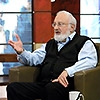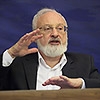Reaching Happiness
 Opinion (Hugh Mackay, social researcher, author of twelve books, including five bestsellers): “I actually attack the concept of happiness. The idea that – I don’t mind people being happy – but the idea that everything we do is part of the pursuit of happiness seems to me a really dangerous idea and has led to a contemporary disease in Western society, which is fear of sadness. It’s a really odd thing that we’re now seeing people saying ‘write down 3 things that made you happy today before you go to sleep,’ and ‘cheer up’ and ‘happiness is our birthright’ and so on. We’re kind of teaching our kids that happiness is the default position – it’s rubbish. Wholeness is what we ought to be striving for and part of that is sadness, disappointment, frustration, failure; all of those things which make us who we are. Happiness and victory and fulfillment are nice little things that also happen to us, but they don’t teach us much. Everyone says we grow through pain and then as soon as they experience pain they say ‘Quick! Move on! Cheer up!’ I’d like just for a year to have a moratorium on the word ‘happiness’ and to replace it with the word ‘wholeness.’. Ask yourself ‘is this contributing to my wholeness?’ and if you’re having a bad day, it is.”
Opinion (Hugh Mackay, social researcher, author of twelve books, including five bestsellers): “I actually attack the concept of happiness. The idea that – I don’t mind people being happy – but the idea that everything we do is part of the pursuit of happiness seems to me a really dangerous idea and has led to a contemporary disease in Western society, which is fear of sadness. It’s a really odd thing that we’re now seeing people saying ‘write down 3 things that made you happy today before you go to sleep,’ and ‘cheer up’ and ‘happiness is our birthright’ and so on. We’re kind of teaching our kids that happiness is the default position – it’s rubbish. Wholeness is what we ought to be striving for and part of that is sadness, disappointment, frustration, failure; all of those things which make us who we are. Happiness and victory and fulfillment are nice little things that also happen to us, but they don’t teach us much. Everyone says we grow through pain and then as soon as they experience pain they say ‘Quick! Move on! Cheer up!’ I’d like just for a year to have a moratorium on the word ‘happiness’ and to replace it with the word ‘wholeness.’. Ask yourself ‘is this contributing to my wholeness?’ and if you’re having a bad day, it is.”
My Comment: Kabbalah offers relationship to the world in the middle line—to determine everything according to the benefits of achieving the goal of existence, which is on the convergence of happiness and difficulties. But it is necessary to reveal the true purpose that can be only above the life that leads to this goal, and to compare what is happening with the approach of the target.
[154908]
Related Material:
If You Want To Be Happy, Then Just Let It Be!
Find The Formula For Happiness
Instructor Of Attaining Happiness











